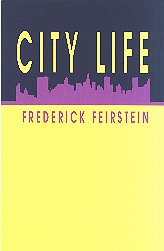
Rhyme, Part 3 of 3
by Frederick Feirstein
Copyright (c) 1996 by Frederick Feirstein
Reprinted by Special Permission of Frederick Feirstein, 1996
and Story Line Press, 1996
Not to be distributed in whole or in part for commercial purposes.
Guest Essayist: Fred Feirstein

Copyright (c) 1996 by Frederick Feirstein
Reprinted by Special Permission of Frederick Feirstein, 1996
and Story Line Press, 1996
Not to be distributed in whole or in part for commercial purposes.
When Time clicks shut its black parenthesis Around Allen, Dick l939 dash, Will all our poems disintegrate to ash, Even your masterpieces, even this Passage I am writing now? Tell me, Dick, Will everything be gone, your cry to seize The day, this, that, that mystic restaurant With all the Catholics, Muslims on their knees, With Cohens pleading in their prayer shawls, With Hari Krishnas madly jubilant, With widowed Sufis shrieking caterwauls, With all your dreams of histories ahead? Will nothing keep of this poor Dick and Fred? Even the echoes of the lines you said, "Can you imagine that? All dead, all dead. All of us dead who never lived enough?" Oh no, dear friend, though sensitive we're tough And, as we have survived this crazy age, We'll talk together, this page with your page. And so we nattered on to celebrate My 45th, circling Thrushwood Lake To find our families still alive, annoyed We took so long, that we had made them wait For me to wish upon my birthday cake: Once upon a time, we were overjoyed.
As we can see in this passage, the lyrical effect of the rhyme and parallelism is very different from its dramatic use in Manhattan Carnival. The insistent double couplet ("ahead," "Fred," "said," "dead") brings the despair established by the relentless parallelism to a lyric intensity that peaks in the first half of the next couplet: "All of us dead, who never lived enough." Then the second half of the couplet is almost comic: "Oh no, dear friend, though sensitive we're tough." Splitting the couplet like this, so that grammatically the rhyme word "tough" leads to the next couplet, helps create the shift in tone that will allow us to move from the tragic to the nonchalant. Now the subtler sestet whose lines are enjambed and whose rhymes are further apart can bring the meditative flight back to where it began, to a nonchalantly rendered every-day reality. The thematic purpose of this shift is to quietly conclude the meditation with the seemingly casual news that a simple family life perhaps represents more of a victory over death than art does. The antithesis of "annoyed" and "overjoyed" and the long "a's" linking the other rhymes make the ending harmonious and at least temporarily reassuring.
The sequence form, though lending itself best to the lyric and meditative poem, can encompass other genres as well. There are a few short narratives in Ending The Twentieth Century, and rhyme helps develop them in ways called for by that genre. "Underground Song," for example, is a short narrative juxtaposed for dramatic purposes to "Celebrating." It is not only in a contrasting genre but also in a contrasting mood, and carries the theme of art and mutability forward in a darkly low comic way. "Underground Song" is in quatrains rhyming abba and describes a shockingly different Manhattan from the one in "Celebrating"; the celebrating that goes on here becomes a bizarre parody. The poem begins with a description of a subway conductor in a Metropolitan Transit Authority uniform:
Authoritative in his blue MTA Uniform, The Conductor opens subway doors For bank clerks, beggars, salesmen, loonies, whores Jostling and cursing, going to hell each day Under ads for face lifts, attack dogs, free Trauma clinics, hotlines for crack addiction, Numbing newspapers, escapist fiction, Schools for Beauty -- canvasses for graffiti.
I used the abba stanza for a variety of reasons. It contains the couplet which (as in "crack addiction/escapist fiction") is perhaps the best form for making satirical comparisons. It also helps create counterpoint, very useful for capturing the physical movements of the characters, and for propelling narrative movement. For instance, in the first stanza above, linking "whores" poetically with "doors" (calling for closure) but grammatically with the next five lines helps establish the counterpoint which, along with the trochaic reversals and frequent caesuras, auditorily captures the herky-jerky movement of the jostling riders. We can see a similar effect in the first stanza of the following passage where Conductor is doing an Elvis Presley imitation to entertain his passengers:
He sings two choruses of Jailhouse Rock. The crowd bewildered giggles, shrugs, snorts, grins. He flails his arms, he shakes his head, he spins Singing, "Everybody in the whole cell block Are dancing to the Jailhouse Rock. And they do. The whole motley car, half of them high, Are singing, rocking to this lullaby Until the train stops. "For those of you Going," he shouts," to Heartbreak Hotel Where you wake up half the night to screams, Gunshots coming from windows or from dreams, Remember Elvis loves you and be well, In SRO's where no phone ever rings, Where you cook dinner on a hot plate, where You fall asleep to t.v. in a chair, Remember, somewhere, New York City sings."
Here the end-stopping of the couplet along with the three strong stresses at the end of line two lead us to expect closure. Instead the rhyme grammatically carries over to line four beginning with the trochee "singing." The effect once again is to throw off expectations auditorily, thereby capturing along with meter the small spinning dance step the Conductor takes.
The quatrain is also useful for establishing quick shifts of tone that also helps develop character in the short narrative. We can readily see this in the passage just quoted where the Conductor becomes a bizarre and temporary parent in this infantile nightmare world -- in dramatic contrast to the parents and children in the daylit world of "Celebrating." The juxtaposition is reinforced by the contrasting shifts in tone, and the tone is established in part by rhyme. Whereas "Celebrating" moves from despair to a blissful familial ending, in "Underground Song" the shift in tone is reversed, from the peculiarly familial atmosphere of the train to the despair of the isolated SRO (Single Room Occupancy) hotel. This shift is precipitated by the nightmarish couplet, "Where you wake half the night to screams/ Gunshots coming from windows or from dreams." Then the quatrain opens out to the mock-lullaby line, "Remember Elvis loves you and be well" and runs on through the next stanza of the quatrain until the parallelism of "Remember, somewhere, New York City sings" brings closure to the lullaby. Instead of familial bliss, we get in this poem's ending the image of the subway rider falling asleep in front of a cold mechanical mother, the t.v. set. The rhyme "where/chair" helps capture the despair. "Where" is repeated three times in two lines, so that when its mate "chair" appears, that solitary chair has an inevitability about it.
I hope by now I've illustrated some of the technical ways rhyme can be used to create various dramatic and lyric effects in the genres that call for them. I'd like to conclude by simply mentioning one more aspect of rhyme, having to do with meaning. Rhyme sometimes helps create a subtext for the poem, especially the dramatic and narrative poem, by connecting associative paths that upon close examination lead to unconscious personal and universal fantasies. For a detailed commentary on this aspect of rhyme, please let me refer you to an essay of mine, "Psychoanalysis and Poetry," in New Essays on Form and Narrative(/I> (edited by Annie Finch, Story Line Press, l995).
Frederick Feirstein
Look for Frederick Feirstein's New and Selected Poetry soon from Story Line Press. January's guest essayist will be Annie Finch.Ending the 20th Century.

City Life (Story Line Press, 1991)
(Amazon) (including the The Psychiatrist at the Cocktail Party)
Story Line Press
1991